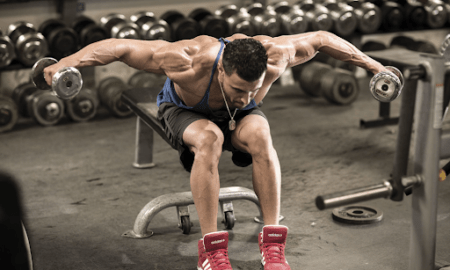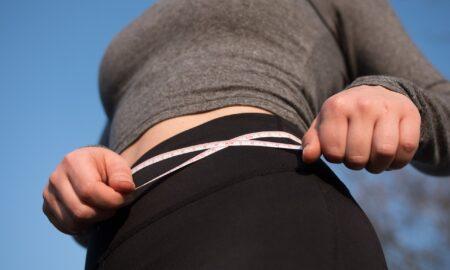A couple of weeks ago, as I was preparing for the NPC Europa Super Show, I posted a status update on Facebook stating that I was off to do cardio. I received a comment on my status that asked, “Do you ever see any buff sprinters doing cardio? No. They stay lean and muscular from doing high-intensity work.” Because I’m very busy with my contest prep and training my clients, I didn’t respond. I just didn’t have time to get into an exchange of words about my contest-prep strategy.
I posted another status update that said I’d had a great shoulder and arm workout and had one more cardio session to do. The same gentleman posted the following comment: “Dave, cardio promotes gluconeogenesis, or loss of BCAAs [branched-chain amino acids] from the very muscles you’ve worked hard to build as part of the metabolic damage induced. Boxers, gymnasts, sprinters, speed skaters and others NEVER do CARDIO to get ripped: Their training keeps them that way. Cardio recovery occurs in three minutes while MET will keep metabolism high for four to 24 hours postworkout.”
Now, I’m a very easy-going dude. But I have more than 3,000 friends on my Facebook account—most of them fans—and getting called out about my tried-and-true contest preparation on my own profile page (not once, but twice) really got under my skin. I hate to argue, but as it happened, I was needing a good topic for my column.
The first thing that came to my mind when I saw the post about buff sprinters was that I’d gladly compete on a bodybuilding stage against Hussein Bolt, Tyson Gay or Carl Lewis in his prime any day of the week. While those amazing athletes are lean and relatively muscular—and would make me look like I was backing up if I had to race them—I’d make them look like toothpicks in a physique contest. They all look “buff” on camera, but they carry nowhere near the amount of muscle relative to their frame that a good competitive bodybuilder carries. On TV you see the best sprinters in the world—the guys and gals loaded with a ridiculously high percentage of fast-twitch fibers. They have the best coaches and best nutritionists—and sometimes the best pharmacologists. I’ve seen some very good high school sprinters who weren’t anywhere close to ripped. Besides, guess what? I don’t want to look like a sprinter anyway. One more thing: When I was a sprinter, we did cardio.
Let’s move on to the second point: Cardio promotes gluconeogenesis and loss of BCAAs. Gluconeogenesis is the conversion of protein into carbohydrates when glycogen stores are depleted. I’m not a fan of the low-carbohydrate diet because I don’t want to deplete my glycogen stores to the point where my body converts protein into glucose. In high-intensity exercise glucose is the primary energy source, so glycogen stores are used at a faster rate. During moderate-intensity cardio, carbohydrates are burned as the primary source of energy for the first few minutes, but as exercise continues a great percentage of the fuel comes from fat. Gluconeogenesis will occur if aerobic exercise is continued for long enough that glycogen stores become depleted.
To avoid that situation, I keep most of my cardio sessions at about 65 to 70 percent of my max heart rate for 30 to 45 minutes. I usually do a fast walk—4.0 to 4.3 miles per hour—and burn between 200 and 300 calories during the exercise bout. While I don’t expect those sessions to elevate my metabolism for hours, I’m quite certain that I’m not back down to baseline in three minutes. Often I do multiple cardio sessions per day so that my daily expenditure during the cardio bouts averages about 500 calories a day. That alone is enough to burn a pound of bodyfat a week.
I’m against using high-intensity exercise to burn off fat during contest preparation. My weight-training sessions are so intense that doing more high-intensity work for fat burning dramatically cuts into recovery from my weight workouts. I lose strength, and my joints get very sore. Second, the risk of injury is much greater on high-intensity conditioning work.
About 10 years ago I decided that doing sprints would be good for my legs and for burning a lot of calories. On my second day of sprinting—even though I did a very thorough warmup and hadn’t even gotten up to a full-speed sprint yet—I tore a hamstring. The following year one of my top pro bodybuilders asked me about doing sprints for conditioning. I recommended against it and told him my story. He did it anyway and tore a hamstring. Last year Mary Hobbs, an outstanding national-level bodybuilder, was in tremendous shape and tore a calf muscle sprinting ramps in preparation for the USA Championships.
The risk is too great when you’re just weeks from a contest, your bodyfat is extremely low and you’re subsisting on restricted calories. Frequent but relatively brief moderate-intensity cardio from which I can easily recover is best. I think my weight-training sessions are enough to elevate my metabolism for hours.
Concerning the loss of BCAAs, it’s so hot here that when I go out to do my walks, I always carry a bottle of water. Even though I think my cardio sessions are short enough that I’m not tapping into BCAA pools, I add two scoops of Xtend, a BCAA supplement by Scivation, to my water, just to be on the safe side.
Now, getting back to what kind of athletes “never do cardio,” while I don’t see any reason for gymnasts to do cardiovascular exercise in their training, they do have to control their bodyweight, and my understanding is that they generally do that through diet. Once again, whenever we see gymnasts on TV, we’re seeing the best in the world. Those young men and women are extremely lean, but if you go to a high school or college gymnastics meet, you’ll see that not all gymnasts are ripped.
The statement that boxers and speed skaters never do cardio was just ignorant. The professional boxers that I know personally do a great deal of running. And speed skaters never do cardio? Are you kidding me? The racing distances in speed skating range from 500 to 10,000 meters. Racing at 10,000 meters requires a great deal of cardio.
What bothered me most was that I was being told on my profile page that I’m going about my contest preparation all wrong by someone who—to my knowledge—has never donned posing trunks. I’m in the midst of my 27th year of bodybuilding competitions, and, considering my record, I think I deserve a little more respect than that. I’ve been using the same basic precontest strategy very successfully for 27 years with little tweaks from year to year. I’m not a huge guy, even off-season, yet over the past 15 years I’ve won 18 titles—nine of my wins were in international competitions—in 32 contests, taken 10 second-place trophies, three thirds and one fourth, my lowest placement in the past 15 years.
I’ve used the same strategy to help many clients win bodybuilding and figure titles over the years. With just a quick glance around my office I count 24 champions I’ve trained—all of them drug-free athletes. In 2007 three top-level WNBF pro natural bodybuilders contacted me to see how I get so ripped yet retain so much muscle. These were athletes who were all placing in the top three at the WNBF Pro Natural Universe and Pro World Championships. Following my advice, 54-year-old Joan Lopez won the ’07 Pro Universe. Brian Whitacre won the lightweight class at the ’07 Pro World Championships. Jim Cordova won the middleweight and overall titles at the ’07 Pro World Championships. And ’05 Pro Natural World Bodybuilding champion Nancy Hanna was also a client of mine. My point is that my system works—not just for me but for many others.
My plan is simple: Use weight training to build and shape your muscle, and use diet and cardio to reduce your bodyfat to ridiculously low levels for competition. The first thing I tell everyone I work with is that you want to do as little cardio as you can get away with while dropping bodyfat at the rate that you need to drop. Being able to prepare for a show with no cardio is the ideal scenario because then you have more energy to use in recovery from your weight training. In my experience, though, that’s seldom the case. My strategy of using a basic weight-training program, along with a high-protein, moderate-carb, relatively lowfat diet and a sensible amount of moderate-intensity cardiovascular exercise works extremely well for me and all of the clients I’ve trained who were diligent about following the plan.
If your body can tolerate high-intensity conditioning and that gets you shredded, then by all means get after it. Please, though: Don’t call me out publicly. You might end up getting talked about in IRON MAN. Notice I didn’t mention any names—the gentleman who wrote the comments is a friend of mine and is a pretty sharp guy.
Editor’s Note: See Dave Goodin’s blog at www.IronManMagazine.com. Click on the blog selection in the top menu bar. To contact Dave directly, send e-mail to [email protected]. IM




















You must be logged in to post a comment Login